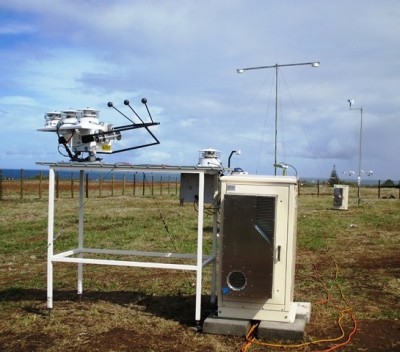New Climate Research Site in the Azores Fills Critical Data Gap
Published: 17 October 2013

How do atmospheric scientists study the flow of energy above the Atlantic Ocean? For starters, they need data—ideally on a continual basis. And that’s exactly what they now have, thanks to a new climate research site installed in the Azores by the U.S. Department of Energy.
As of October 1, the DOE’s Atmospheric Radiation Measurement (ARM) Climate Research Facility began providing the research community with continuous data about clouds, aerosols, energy, and precipitation from Graciosa Island in the Azores, Portugal. Installed by a team from Los Alamos National Laboratory, the new observation site mirrors ARM’s other long-term atmospheric measurement stations around the world. This newest outpost is broadly referred to as the Eastern North Atlantic, or ENA, site.
Site operations began with the launch of an inaugural weather balloon on September 28, just one week after the LANL team arrived to complete the installation. Several more instruments came online soon after that, as the experienced team worked quickly and efficiently to integrate the site data systems.
“LANL has operated the original ARM Mobile Facility for nearly 10 years now, so we’re a pretty well-oiled machine,” said Paul Ortega, ENA site manager from LANL and the install team leader. “Plus, having established relationships on Graciosa from the previous deployment, there was much less new ground to cover, so to speak.”
Ortega is referring to a two-year deployment of the first ARM Mobile Facility, or AMF1, a portable version of the fixed sites that provides most of the same measurement capabilities. From May 2009 through December 2010, the AMF1 obtained a valuable scientific data set that cemented the decision to establish the long-term site on Graciosa.
Starting Small Leads to Science Success

In 2007, ARM led a workshop with 34 scientific experts in the areas of remote sensing, process studies, cloud system modeling, general circulation modeling, and decision support. Their goal was to assess options for expanding and enhancing ARM’s observational network to best advance the science of cloud radiative forcing processes relevant to improving global climate models. As described in the workshop report, the Azores emerged as one of the top five places to establish a long-term observatory for obtaining a statistical data set of particular importance to the modeling community.
Shortly after this workshop, ARM approved a science proposal to deploy its mobile facility to Graciosa Island in 2009 for the year-long Clouds, Aerosol, and Precipitation in the Marine Boundary Layer field campaign. Extended to 20 months, this highly successful deployment resulted in a rare data set of marine stratocumulus clouds from this region, and confirmed that the Azores have the ideal mix of conditions to study how clouds, aerosols, and precipitation interact.
Bigger and Better
Based on their experiences during the original AMF1 deployment, the Regional Government of the Azores and scientific colleagues at the University of the Azores gave their full support to the new site. In March 2012, the Mayor of Graciosa allocated a significant tract of land not far from the original deployment site. Compared to that temporary deployment, the new fixed site has significant instrument enhancements, including scanning cloud and precipitation radars, a Doppler lidar, and an upgraded Aerosol Observing System, or AOS (see Field Notes Blog for details).
Eduardo Brito de Azevedo, ENA resident site manager and research team leader from the University of the Azores, is responsible for outreach and relationships between the project and the Regional Government of the Azores. He was also instrumental in assisting with site logistics, including import processes.
“With this project, the Azores have found again its natural vocation as an international geostrategic platform for meteorological and climatic studies in the middle of the vast north Atlantic basin, where climate system plays fundamental processes of interaction between atmosphere and the ocean,” said Azevedo.
Most of the instruments went through integration and beta testing at the Los Alamos Staging Facility in New Mexico over the summer of 2013. From there, they were trucked to Virginia Beach, Virginia, for the overseas journey to the Azores. Meanwhile, local contractors on Graciosa began site excavation and infrastructure in August in preparation for the arrival of the instruments and equipment. (See the ENA photo set in Flickr.)

Carlos Sousa, a Graciosa Island native, is the resident technician for the new ENA site. He cut his teeth with the AMF team during the previous deployment on Graciosa, and has since gained additional experience during AMF operations in both India and the United States.
“One night in India, I got a call from Kim Nitschke [AMF1 oversight manager from LANL] telling me about this permanent site at Graciosa. Since that night that, I have been waiting for this day to come,” said Sousa. “It is here now and to say that I am happy would do no justice. Certainly, it’s a great feeling to be part of this operation as the site technician. I cannot forget to thank Mike Alsop that one day he introduced me to AMF1, where it all started for me.”
The ARM Climate Research Facility is a DOE Office of Science user facility. The ARM Facility is operated by nine DOE national laboratories, including .
Keep up with the Atmospheric Observer
Updates on ARM news, events, and opportunities delivered to your inbox
ARM User Profile
ARM welcomes users from all institutions and nations. A free ARM user account is needed to access ARM data.


















